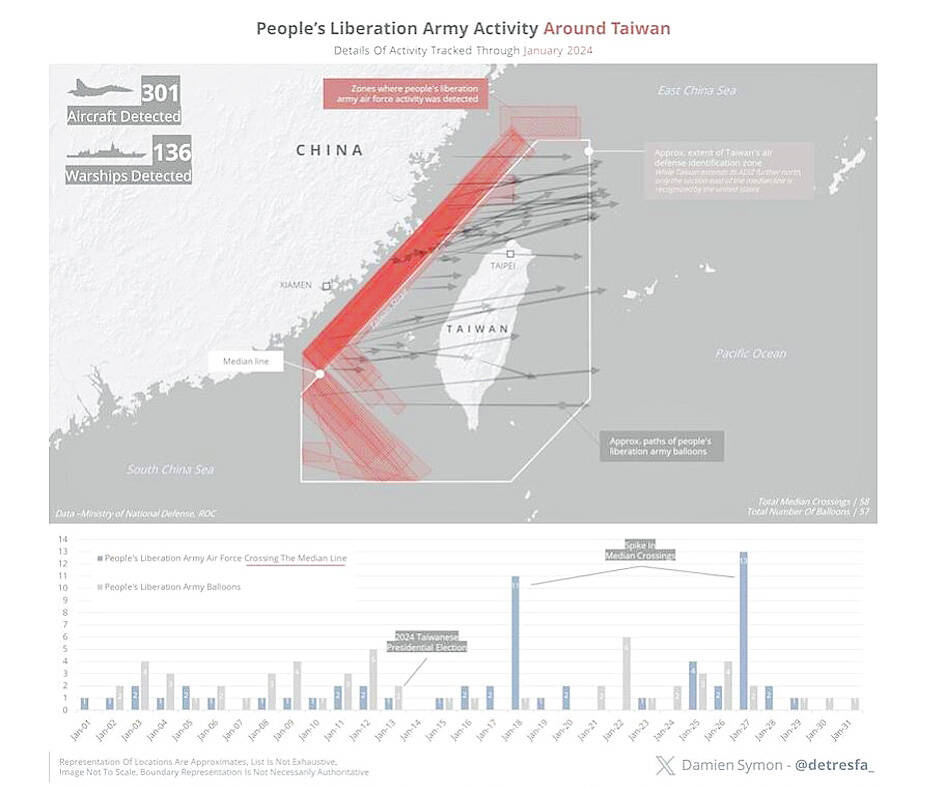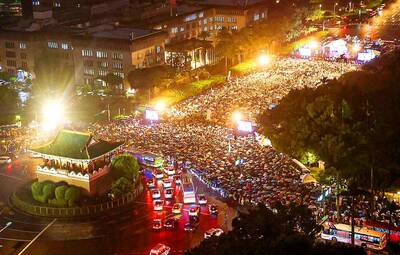An analyst has urged that Taiwan obtain laser weapon systems to counter Chinese balloons after the military last month detected 57 balloons in and around the nation’s airspace.
Aggregated Ministry of National Defense (MND) data showed that last month Beijing sent a flurry of balloons, including many that flew over the sea north of Taiwan proper and some that crossed the median line of the Strait, in addition to several that entered the nation’s airspace.
China sometimes simultaneously deployed as many as six balloons at a time during these operations, the data showed.

Photo: Screen grab from Symon’s X account
The balloons Taiwan encountered were smaller than the one that was shot down over the US and did not pose a serious threat due to the limited payload for weapons and surveillance equipment, Institute of National Defense and Security Research (INDSR) fellow Su Tzu-yun (蘇紫雲) said on Saturday.
Beijing’s use of balloons is part of its influence operations aimed at dealing psychological blows to Taiwanese by presenting the Chinese People’s Liberation Army’s (PLA) as being capable of penetrating the airspace of Taiwan proper, he said.
Should war break out, Beijing could force Taiwan’s armed forces to expend precious air defense missiles to shoot down the relatively low-cost balloons in a ploy to exhaust the defender’s ammunition, Su said.
A possible counter-tactic for Taiwan is the use of directed energy weapons, which cost a few US dollars per shot, whereas missile systems cost millions of US dollars per unit and could be fired only once, he said.
Laser weapons could destroy several targets in rapid succession, have a small logistical footprint, and remain in operation without relying on finite munition stockpiles so long as energy is supplied, Su said.
Chinese balloons have increasingly lengthened their loiter time and their flight path moved closer to Taiwan proper, said retired army major general Ko Yung-sen (柯永森), who is an INDSR fellow.
The PLA is poised to establish a “near space command,” a fifth branch of the Chinese armed forces that would control satellites, drones and balloons to achieve an integrated kill chain for hypersonic missiles and conventional platforms, he said.
China’s Taiwan Affairs Office spokesman Chen Binhua (陳斌華) on Thursday said the balloons floating over Taiwan were civilian craft utilized for peaceful purposes and presented “nothing new.”
Democratic Progressive Party authorities should not use the issue for “cognitive manipulation” that fans hostility across the Taiwan Strait, he said.
Taiwan’s Mainland Affairs Council spokesman Jan Jyh-horng (詹志宏) said Beijing was lying about the balloons.
“No private enterprise has the resources to waste balloons for no reason,” he said. “We completely reject these lies.”
Last month, 301 aircraft and 136 ship sorties were detected in the area surrounding Taiwan, including 58 aircraft sorties that flew over the median line of the strait, MND reports showed.
Many of these sorties flew over the sea to the southwest of Taiwan proper to menace the Pratas Islands (Dongsha Islands, 東沙群島) with aerial interdiction, while a smaller number flew over the nation’s northern waters.
Notably, the MND last month began publishing information on Chinese military aircraft flying beyond Taiwan’s air defense identification zone in a display of detection capabilities likely intended for China.

The Central Weather Administration (CWA) today issued a "tsunami watch" alert after a magnitude 8.7 earthquake struck off the Kamchatka Peninsula in northeastern Russia earlier in the morning. The quake struck off the east coast of the Kamchatka Peninsula at 7:25am (Taiwan time) at a depth of about 19km, the CWA said, citing figures from the Pacific Tsunami Warning Center. The CWA's Seismological Center said preliminary assessments indicate that a tsunami could reach Taiwan's coastal areas by 1:18pm today. The CWA urged residents along the coast to stay alert and take necessary precautions as waves as high as 1m could hit the southeastern

FINAL COUNTDOWN: About 50,000 attended a pro-recall rally yesterday, while the KMT and the TPP plan to rally against the recall votes today Democracy activists, together with arts and education representatives, yesterday organized a motorcade, while thousands gathered on Ketagalan Boulevard in Taipei in the evening in support of tomorrow’s recall votes. Recall votes for 24 Chinese Nationalist Party (KMT) lawmakers and suspended Hsinchu City mayor Ann Kao (高虹安) are to be held tomorrow, while recall votes for seven other KMT lawmakers are scheduled for Aug. 23. The afternoon motorcade was led by the Spring Breeze Culture and Arts Foundation, the Tyzen Hsiao Foundation and the Friends of Lee Teng-hui Association, and was joined by delegates from the Taiwan Statebuilding Party and the Taiwan Solidarity

Instead of threatening tariffs on Taiwan-made chips, the US should try to reinforce cooperation with Taiwan on semiconductor development to take on challenges from the People’s Republic of China (PRC), a Taiwanese think tank said. The administration of US President Donald Trump has threatened to impose across-the-board import duties of 32 percent on Taiwan-made goods and levy a separate tariff on semiconductors, which Taiwan is hoping to avoid. The Research Institute for Democracy, Society, and Emerging Technology (DSET), a National Science and Technology Council think tank, said that US efforts should focus on containing China’s semiconductor rise rather than impairing Taiwan. “Without

The National Museum of Taiwan Literature is next month to hold an exhibition in Osaka, Japan, showcasing the rich and unique history of Taiwanese folklore and literature. The exhibition, which is to run from Aug. 10 to Aug. 20 at the city’s Central Public Hall, is part of the “We Taiwan” at Expo 2025 series, highlighting Taiwan’s cultural ties with the international community, National Museum of Taiwan Literature director Chen Ying-fang (陳瑩芳) said. Folklore and literature, among Taiwan’s richest cultural heritages, naturally deserve a central place in the global dialogue, Chen said. Taiwan’s folklore would be immediately apparent at the entrance of the